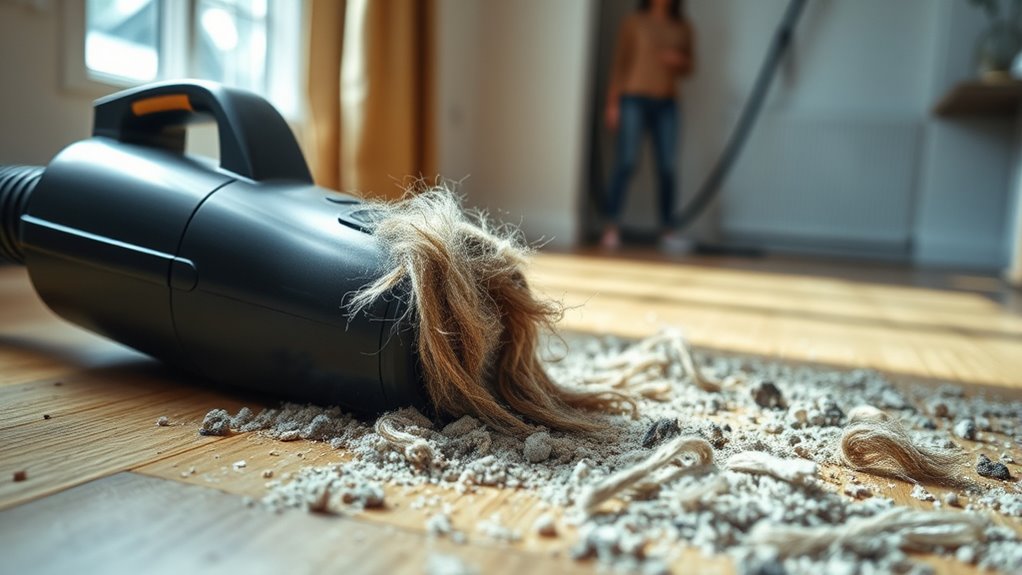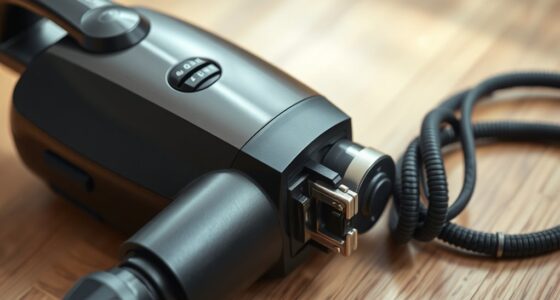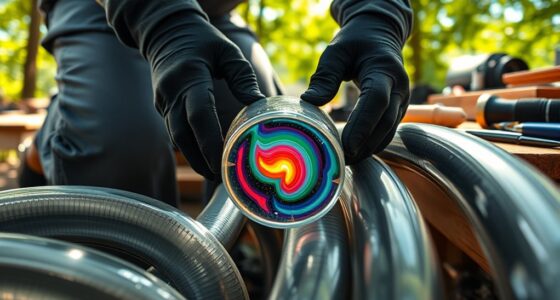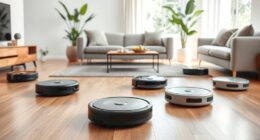If your vacuum’s spitting out dirt, it’s likely due to a full dirt container, clogged filters, or blocked hoses. A full container limits airflow, while clogged filters reduce suction power, preventing proper dirt collection. Check your hoses for blockages, too, as these can lead to poor performance. Keeping your vacuum well-maintained is key to ensuring it works effectively. Want to know how to resolve these issues? There’s more to discover about vacuum maintenance.
Key Takeaways
- A full dirt collection container restricts airflow, causing the vacuum to spit out dirt instead of collecting it effectively.
- Clogged filters can lead to reduced suction power, resulting in dirt being expelled rather than captured.
- Tangled hair and debris around the brush roll hinder its movement, decreasing cleaning efficiency and causing dirt to be released.
- Blockages in hoses prevent proper suction, which can force dirt back out instead of allowing it to be collected.
- Regular maintenance, including cleaning and inspecting all components, is essential to prevent dirt spitting issues.

Have you ever wondered why your vacuum is spitting out dirt instead of sucking it up? It’s frustrating, right? You expect your trusty vacuum to effortlessly collect dirt and debris, but instead, it’s creating a mess. The culprit often lies in a lack of proper vacuum maintenance. When you neglect your vacuum, it can lead to a range of issues that impact its performance.
First off, check the dirt collection container. If it’s full, your vacuum just can’t function effectively. A full container restricts airflow, making it harder for your machine to pull in dirt. Empty it regularly to ensure ideal performance. Don’t forget to clean or replace filters too. Clogged filters can greatly reduce suction power. Make it a habit to inspect and clean them according to the manufacturer’s guidelines.
Check the dirt collection container regularly; a full one restricts airflow and affects suction. Clean or replace filters to maintain peak performance.
Another common issue is a tangled brush roll. Hair, threads, and debris can wrap around the brush, preventing it from spinning properly. This not only reduces your vacuum’s effectiveness but can also lead to motor strain. Take a moment to remove any obstructions from the brush roll. Regularly maintaining this part of your vacuum will help it pick up dirt and debris more efficiently.
You should also inspect the hoses and attachments. Over time, they can become clogged with dust and dirt. A blockage can cause your vacuum to lose suction, leading to dirt being expelled rather than collected. Detach the hoses and check for any blockages. Clear them out, and you’ll notice a considerable improvement in performance.
Don’t overlook the importance of regular maintenance. Just like other household appliances, your vacuum deserves some TLC. Clean the exterior, check for wear and tear, and ensure all parts are functioning correctly. The better you care for your vacuum, the longer it’ll serve you well. Additionally, using vacuums with HEPA filters can significantly enhance allergen control and improve overall cleaning efficiency.
Finally, consider the type of flooring you’re vacuuming. Some vacuums are designed specifically for certain surfaces. If you’re using a vacuum meant for carpets on hard floors, it might not perform as well. Make sure you’re using the right vacuum for your home’s needs.
Frequently Asked Questions
Can Using a Vacuum on Carpet Cause Dirt Spitting?
Yes, using a vacuum on carpet can cause dirt spitting if the vacuum bag is full or the brush roll isn’t functioning properly. A clogged bag restricts airflow, leading to dirt being blown back out. If the brush roll is tangled with hair or debris, it can’t effectively lift dirt, which might also contribute to the issue. Regularly check and maintain your vacuum to avoid these problems and keep your carpets clean.
How Often Should I Clean My Vacuum Filter?
Cleaning your vacuum filter’s like giving your car an oil change; it keeps things running smoothly. You should clean your vacuum filter every month, but if you vacuum frequently or have pets, consider doing it every two weeks. Regular vacuum maintenance helps maintain suction power and prolongs the life of your appliance. Don’t forget to check your filter for signs of wear and replace it when necessary for peak performance!
Is It Safe to Vacuum Pet Hair?
Yes, it’s safe to vacuum pet hair, as long as you use the right vacuum. Make sure your vacuum is designed for pet owners, with strong suction and a brush roll that can handle hair. Regularly clean the filter and brush to maintain vacuum safety. If you notice clogs or decreased performance, it might be time for maintenance. Enjoy a fur-free home by vacuuming regularly and effectively!
What Type of Vacuum Is Best for Hardwood Floors?
For hardwood floors, a vacuum with a soft brush or a suction-only model is best. These types prevent scratches while effectively picking up debris. Remember to prioritize vacuum maintenance by regularly checking and cleaning filters and brushes. Additionally, use hardwood cleaning techniques like vacuuming in the direction of the wood grain to guarantee a thorough clean. Investing in the right vacuum can make a significant difference in keeping your floors pristine.
How Do I Know When to Replace My Vacuum?
Just like a car needs regular check-ups, your vacuum needs attention too. You’ll know it’s time to replace your vacuum when it struggles to pick up dirt, even after proper vacuum maintenance and filter replacement. If you notice unusual smells, excessive noise, or if it’s over ten years old, it’s probably time for a new one. Trust your instincts; a well-performing vacuum makes cleaning effortless and keeps your home fresh.
Conclusion
In the grand vacuum saga, don’t let your cleaning companion turn into a villain. If it’s spewing dirt instead of sucking it up, it’s time for a little TLC. Check for clogs, clean the filters, and empty the dustbin to restore its heroic status. Just like a once-great knight, your vacuum needs upkeep to keep fighting dust and debris. With a bit of attention, you’ll have it back on its noble quest, leaving your floors spotless.









